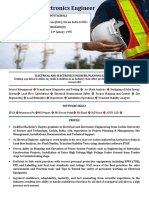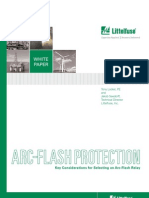Arc Flash NFPA 20101215
Uploaded by
John Fredy Martínez CardonaArc Flash NFPA 20101215
Uploaded by
John Fredy Martínez CardonaDave Sirmans, CMRP
The Snell Group
Arc Flash, NFPA, and OSHA
What’s Real, What’s Not, and What YOU Need
to Do to Ensure Compliance
T
he purpose of an arc flash analysis is to provide
“qualified persons,” who will be performing work on
or near energized electrical equipment, with the infor-
The requirement for performance of an arc flash haz-
ard analysis is documented in several existing industry
standards. The most notable being NFPA-70E, The Hand-
mation they need to protect themselves against the pos- book for Electrical Safety in the Workplace. This standard
sibility of being injured by the release of energy as a is on a four year revision cycle, with the latest revision
result of an arcing fault. It is no secret that electricity having an effective date of September 5, 2008.
can be dangerous. Those of us who work with electric- In Article 130.3 of the 70E, it reads “A flash hazard
ity day in and day out know this to be true. We have all analysis shall (emphasis mine) be done in order to protect
either been exposed to the dangers ourselves or know personnel from the possibility of being injured in an arc
someone who has. The National Institute for Occupa- flash. The analysis shall determine the Flash Protection
tional Health and Safety figures state that between 1992 Boundary, and the Personal Protective Equipment that
and 2001 there were over 17,000 arc flash injuries in the people within the Flash Protection Boundary shall use.”
United States. The requirement is repeated in the 29CFR1910.132(d)
Arc flash is a real problem. Not only is it real, but (1) where it states “The employer shall assess the workplace
it is a danger that extends beyond power plants and to determine if hazards are present, or are likely to be
industrial sites to office buildings, hospitals, schools and present, which necessitate the use of personal protective
retail spaces. Anywhere that electricians or other service equipment (PPE). If such hazards are present, or likely
technicians are performing energized work, the potential to be present, the employer shall select, and have each
exists for an arc flash incident. Not only does the poten- affected employee use, the types of PPE that will protect
tial exist, but the danger is just as high in a 2,000 square the affected employee from the hazards identified in the
foot office as it is in a 500,000 square foot textile plant. hazard assessment.”
This requirement in OSHA is what dictates the use of
safety glasses in environments where there is danger of
eye injury, the use of safety shoes in places where heavy
objects are lifted, and applies to arc flash PPE for “quali-
fied persons” performing energized electrical work.
The IEEE Standard 1584 is the manual for performing
arc flash analysis and it provides formulae and guidelines
for determining the level of hazard involved with differing
types of electrical equipment. There is a provision in this
standard for not performing analysis on certain sizes and
types of systems, but the majority of equipment in most
non-industrial facilities requires analysis to assign risk
levels from which PPE levels are derived. Even in systems
that are of the size and type that don’t require analysis,
they still are required to be labeled to warn of the risk of
arc flash.
© 2011 The Snell Group / www.thesnellgroup.com
This requirement is found in the National Elec- The key to compliance may be found in develop-
tric Code (NEC) in article 110.16. It states that “Switch- ing a relationship with a qualified electrical engineering
boards, panel-boards, industrial control panels, meter consulting firm. With 70E and arc flash having so much
socket enclosures and motor control centers that are in recent exposure, there’s a plethora of outfits that purport
other than dwelling occupancies and are likely to require to perform arc flash analysis that are actually just trying
examination, adjustment, servicing or maintenance while to capitalize on the growing trend. A qualified firm will
energized shall (emphasis mine) be field marked to warn have electrical system testing and/or design experience
qualified persons of potential electric arc flash hazards.” going back a number of years, not months. Your elec-
This edict leaves out “dwelling occupancies” or homes, trical contractor might not be the best bet either, since
therefore stating that your office building, hospital, or the calculations required for accurate figures are the sort
school building still requires labeling, even if the system of thing suited for engineers, not electricians. Beware of
size and type meets the non-analysis criteria. outfits that claim to be able to show up at your facility a
There is also some misunderstanding regarding the single time and be able to perform a complete analysis.
relationship between OSHA and the NFPA. The NFPA is The analysis is a nine step process. These steps are out-
the National Fire Protection Association. They are a con- lined below.
sensus based organization that exists for the prevention of • Collect system and installation data
fires and fire related injuries. They publish the NEC under • Determine system modes of operation
document number NFPA-70. They also publish numerous • Determine bolted fault currents
standards on fire code related subject matter, including • Determine arc fault currents
sprinkler systems or extinguishing agents. • Find protective device characteristics and duration
OSHA is the Occupational Safety and Health of arcs
Administration. They are a governmental regulatory body; • Document systems voltages and classes of
the safety police. If there is a lost time accident in your equipment
facility, it’s OSHA who shows up. If the accident involved • Select working distances
electricity, they will reference NFPA-70E. In 1975, OSHA • Determine incident energy for all equipment
requested a new electrical safety standard. The publica- • Determine flash protection boundary for all
tion of that standard was awarded to NFPA. They issued equipment
the standard in sections at first, but in 1993 it was released Most of the more
in its entirety. The 1995 revision was the first consensus experienced firms
standard to address the danger of arc flash, and to have can offer a complete
provisions for protective apparel. compliance solution,
The most recent revision had some changes from the from analysis all
previous one, but most of them are in smaller areas and the way to your
the requirements for PPE and analysis still stand. Many safety program and
groups believe that having an analysis and warning labels required training.
on their electrical panels constitute complete NFPA-70E This is a serious
compliance. These measures are a great place to start, business, liability must
but they are the tip of the proverbial iceberg. A compre- be avoided when
hensive electrical safety plan is also essential. Your safety possible, and reduced
program has to be tailored to your particular needs, in when avoidance
terms of the size and type of your electrical apparatus cannot occur.
and the energies associated with it. All personnel who Electrical safety today,
may perform energized electrical work must be identified and in the future,
and trained in electrical safety, to include hazard recogni- includes compliance
tion, and the injuries associated with the size and type of with the NFPA-70E.
equipment to which they will be exposed. Get onboard!
© 2011 The Snell Group / www.thesnellgroup.com
You might also like
- OSHA 30 Construction Final Test Answer Key71% (154)OSHA 30 Construction Final Test Answer Key74 pages
- IICRC - S500 - Professional Water Damage Restoration88% (8)IICRC - S500 - Professional Water Damage Restoration82 pages
- OSHA 10 Hour General Industry Final Exam Answer Key75% (12)OSHA 10 Hour General Industry Final Exam Answer Key11 pages
- OSHA 10 Construction Final Exam Answer Key77% (13)OSHA 10 Construction Final Exam Answer Key18 pages
- OSHA 10 Hour General Industry Final Exam Answer Key71% (28)OSHA 10 Hour General Industry Final Exam Answer Key11 pages
- SM Dx480lca K Dx520lca K Shop Manual (950106 01846e) en100% (4)SM Dx480lca K Dx520lca K Shop Manual (950106 01846e) en846 pages
- DT 466 / DT 570 Diesel Engine Diagnostic Manual97% (37)DT 466 / DT 570 Diesel Engine Diagnostic Manual665 pages
- Facility Safety Checklist: Personal Protective Equipment Emergency/Osha Related Items100% (2)Facility Safety Checklist: Personal Protective Equipment Emergency/Osha Related Items2 pages
- Den-Jet Ce20-500 - Super Slim Manual - Jul 2015No ratings yetDen-Jet Ce20-500 - Super Slim Manual - Jul 201531 pages
- Certified Maintenance and Reliability Technician100% (1)Certified Maintenance and Reliability Technician26 pages
- Guide To Compliance With The Electrical Workplace Safety Standards in The United StatesNo ratings yetGuide To Compliance With The Electrical Workplace Safety Standards in The United States3 pages
- Webinar Weigel Electricalsafety PresentationNo ratings yetWebinar Weigel Electricalsafety Presentation55 pages
- A Time-Current Curve Approach To Arc-Flash Hazard AnalysisNo ratings yetA Time-Current Curve Approach To Arc-Flash Hazard Analysis14 pages
- Electrical Safety in Battery Maintenance and Testing PDFNo ratings yetElectrical Safety in Battery Maintenance and Testing PDF7 pages
- Electrical Engineer Power Systems in USA Resume Yashpal VyasNo ratings yetElectrical Engineer Power Systems in USA Resume Yashpal Vyas1 page
- Electrical Installation Condition Reporting:: Classification Codes For Domestic and Similar Electrical InstallationsNo ratings yetElectrical Installation Condition Reporting:: Classification Codes For Domestic and Similar Electrical Installations20 pages
- Fluke Electrical Testing Safety (3392477 6003 ENG C W)No ratings yetFluke Electrical Testing Safety (3392477 6003 ENG C W)4 pages
- A Step-By-Step Guide To Formal Visual Inspection of Electrical EquipmentNo ratings yetA Step-By-Step Guide To Formal Visual Inspection of Electrical Equipment9 pages
- Arc Flash Hazard Analysis Study Specification Corpor AtionNo ratings yetArc Flash Hazard Analysis Study Specification Corpor Ation25 pages
- Module 103 - Electrical Hazard Recognition (2)100% (1)Module 103 - Electrical Hazard Recognition (2)9 pages
- Hilton Hotel and Royale Palms Myrtle Beach, South Carolina July 11, 2011No ratings yetHilton Hotel and Royale Palms Myrtle Beach, South Carolina July 11, 201174 pages
- Electrical Installation Condition Reporting:: Classification Codes For Domestic and Similar Electrical Installations100% (1)Electrical Installation Condition Reporting:: Classification Codes For Domestic and Similar Electrical Installations20 pages
- Protection, Control and Operation of Transformer Using Numerical RelayNo ratings yetProtection, Control and Operation of Transformer Using Numerical Relay11 pages
- Enhanced With Multiple Language Support: Modules (Enhanced) Templates One-Line DiagramNo ratings yetEnhanced With Multiple Language Support: Modules (Enhanced) Templates One-Line Diagram2 pages
- White Paper: Key Considerations For Selecting An Arc-Flash RelayNo ratings yetWhite Paper: Key Considerations For Selecting An Arc-Flash Relay7 pages
- Infrared Thermography: Electrical Inspections100% (1)Infrared Thermography: Electrical Inspections46 pages
- Directorate of Electrical Safety Inspection - Compliance Report 2020No ratings yetDirectorate of Electrical Safety Inspection - Compliance Report 20204 pages
- Guide Interpreting Requirements of Articles 500 516 of Nec Appleton en 7496060100% (1)Guide Interpreting Requirements of Articles 500 516 of Nec Appleton en 7496060212 pages
- Arc Flash Hazard Calculation in 9 Steps Using IEEE 1584No ratings yetArc Flash Hazard Calculation in 9 Steps Using IEEE 15845 pages
- 6th Sem - 4 - Electrical Engineering PDFNo ratings yet6th Sem - 4 - Electrical Engineering PDF37 pages
- Safety Aspects of Green Hydrogen Production On Industrial Scale-Public ReportNo ratings yetSafety Aspects of Green Hydrogen Production On Industrial Scale-Public Report58 pages
- Understanding The Automatic Voltage Regulation of Alternator or GeneratorNo ratings yetUnderstanding The Automatic Voltage Regulation of Alternator or Generator3 pages
- Anderson Leon Diaz John Fredy Martinez CNo ratings yetAnderson Leon Diaz John Fredy Martinez C20 pages
- Ultimate Survival Skills Handbook and Checklist100% (25)Ultimate Survival Skills Handbook and Checklist88 pages
- Transp Ortation 101:: Implementin GAN Effective Safet Y Progr AM100% (2)Transp Ortation 101:: Implementin GAN Effective Safet Y Progr AM9 pages
- Improving Your Self-Esteem: Information For ClientsNo ratings yetImproving Your Self-Esteem: Information For Clients12 pages
- Kartbuilding Blog: Archive For The 'Chassis Design' CategoryNo ratings yetKartbuilding Blog: Archive For The 'Chassis Design' Category9 pages
- Variable Valve Timing and Lifting Technologies in Different Automobiles CompaniesNo ratings yetVariable Valve Timing and Lifting Technologies in Different Automobiles Companies5 pages
- Acetylene Gas C2H2 Safety Data Sheet SDS P4559No ratings yetAcetylene Gas C2H2 Safety Data Sheet SDS P455910 pages
- How To Manage Work Health and Safety Risks: Code of PracticeNo ratings yetHow To Manage Work Health and Safety Risks: Code of Practice38 pages
- Almond Amaretto Contiene Metil CiclopentonoloneNo ratings yetAlmond Amaretto Contiene Metil Ciclopentonolone5 pages
- Confined Space Fuel Tank Entry Safety Awareness Training (Rev2)No ratings yetConfined Space Fuel Tank Entry Safety Awareness Training (Rev2)51 pages
- Method of Statement For Site DemobilizationNo ratings yetMethod of Statement For Site Demobilization11 pages
- Hazards During Chemicals in Use and Safety GuidelinesNo ratings yetHazards During Chemicals in Use and Safety Guidelines18 pages
- PTS 60.3401 - Decommissioning, Remediation and Reclamation of On-Shore E and P Sites (Guideline)No ratings yetPTS 60.3401 - Decommissioning, Remediation and Reclamation of On-Shore E and P Sites (Guideline)127 pages
- Safety Requirement in Marine EngineeringNo ratings yetSafety Requirement in Marine Engineering24 pages
- Ip Solvent - 2028 - JP01 (En) - 20190307No ratings yetIp Solvent - 2028 - JP01 (En) - 201903077 pages
- Acido Grabador en Gel - Msds - Jade Etchant Gels1No ratings yetAcido Grabador en Gel - Msds - Jade Etchant Gels15 pages
- Training Regulations: Aquaculture NC IiNo ratings yetTraining Regulations: Aquaculture NC Ii64 pages























































































































